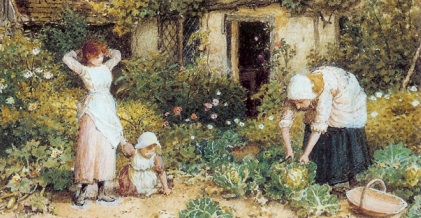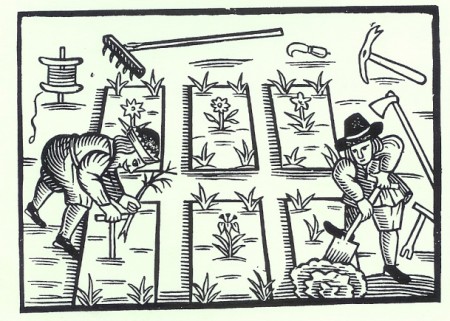Heirloom vegetables and flowers (or as well call them over here – heritage) have been big for some time now. Much more so in North America than home. In fact I am always really surprised about how enthusiastic American gardeners are about ‘vegetables our grandmothers grew’. The love of heirloom veg however goes along with a certain hostility to modern varieties, and modern breeding methods such as F1 hybridisation, particularly claims that heirlooms taste better; there is also an undercurrent that heirlooms are somehow better for the world, more ethical. Here I’d like to challenge this and stand up for modern scientific plant breeding. There is also a political point I’d like to make.
First, the taste thing. Commercial growers don’t like heirlooms (poor yielding, finickity, unreliable) so the ‘standard’ varieties in the shops have sat around for a bit and are not going to taste as fresh as ones cut a couple of hours ago in the garden, which is where the majority of heirlooms are grown. So – a myth is born, that moderns are less tasty.
Yes, it is fun to grow heirlooms – the wonderful names, the good looks of some, the connection with the past etc etc, but are we gardening or running a museum? Is gardening just a hobby or are we trying to do something a bit more serious, like reducing our ‘food miles’ and growing fresh food we know we have some control over? There are folk who spend time and money doing up old cars, but do they drive to work in a Model T Ford? Or those who love heirloom clothes but do they turn up for work in a crinoline, or gaiters, or a top hat and tails? No. So why the obsession with heirloom veg?
My experiences with heirloom veg has left me yearning for more modernity. Kale ‘Nero di Toscana’ looks good, but it’s like eating leather. Beetroot ‘Chioggia’ looks beautiful grated in a salad but cooked into borsht it looked so disgusting (grey) that my wife threw it out. Tomato ‘Gardener’s Delight’ sure tastes good, but it splits (and then rots) faster than any other tomato.
Almost by definition, a new variety has to be better than an old one, otherwise why put it on the market. Nearly all veg is bred for commercial growers of course, not home gardeners, but for the most part all growers want the same: reliable, high-yielding, good-looking, tasty and disease and stress-resistant plants. The only time the commercial and the home grower really separate is over harvest time, as there are certain crops which the commercial grower needs to harvest all at once and which won’t stand but which the home grower wants for as long as possible – for this reason I would never touch F1 broccoli – I want the stuff for months, not all at once.
Modern breeding uses a range of techniques to bring genes together to improve our crops, often incorporating a wide range of genetic diversity: e.g. genes from flavour from one variety – maybe from Russia, for productivity from another – maybe from Italy, for virus-resistance from a wild relative, etc etc. Modern varieties may contain genes from tens of traditional ones or wild ancestors. Those with small gardens and not much time (i.e. most of us) want varieties which are consistent and reliable. And…. even if we are not card-carrying organic growers, we don’t want to spray. One of the biggest areas of modern plant-breeding is to produce varieties which are resistant to common pests and diseases – so now we have carrots resistant to carrot fly, potatoes to potato blight and tomatoes to a whole raft of nasty pathogens.
Heirloom varieties need proper management if their special qualities are to survive from year to year. The danger with their current high-fashion status is that this doesn’t happen, small inexperienced businesses save seed gets from year to year, with small changes accumulating which eventually dilute the original distinct characteristics of the variety. ‘Seed exchanges’ are worse, they may be fun, but they are a recipe for poorly managed genestocks getting muddled. Commercially-managed ‘open-pollinated’ seed varieties are at least professionally managed for consistency.
Most veg varieties are still open-pollinated as opposed to F1s where two distinct varieties are crossed to produce a ‘one-off’ seed crop – sow the seed from an F1 and you get something very different next year (and usually nothing like as good). So F1 seed does commit you to buying fresh every year. There have always been suspicions that the seed trade has deliberately promoted F1 varieties in order to stop growers saving their own seed. This may be true, and an issue for poor farmers in developing countries, but how many of us are going to begrudge spending an extra dollar on a packet of seed which delivers what F1s do so well – consistent and reliable crops, often with a special factor bred in – many of the best disease-resistant varieties are F1 for a very good reason – that the resistance cannot be bred into open-pollinated varieties.
As I said, I don’t recommend them for crops which have a short cropping period, but for cabbages, leeks, tomatoes and indeed most veg, I buy F1 if I get the chance. It is F1 technology which gives us slow-to-bolt Chinese cabbage, fly-resistant carrots and….. the clincher…… sweet corn which doesn’t lose flavour five minutes after picking. “I rest my case” as they say in courtrooms over here.

'Cutting Cabbages', a British romantic painting of the Victorian era. I think these cottagers would have dropped their 'heirlooms' for our modern varieties at the drop of a hat (or bonnet).
I’m going to end on a political note. I think the heirloom veg obsession is part of a way we see farming and growing through a rose-tinted romantic glass. Can we get real please? We have got more and more people on this earth to feed, they want more and more of the good stuff which we in the rich world take for granted, the climate is changing, and farmers need to produce to earn money – to lift them out of poverty in many cases. Sniping at the Green Revolution (which saved the world from famine in the 1960s) has given way to denunciations of the GM technology which has been an enormous breakthrough in breeding (cornborer- resistant corn, bollworm-resistant cotton, and just about to come out – corn which needs less water). Its high time we stopped being romantic about food production. Lets embrace the plant breeding technology which has always fed us, and make a start in our own vegetable gardens.


